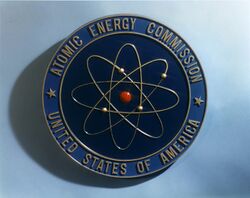US/Atomic Energy Commission
(Government agency) | |
|---|---|
 | |
| Formation | 1946 |
| Extinction | 1975 |
| Subpage | •US/Atomic Energy Commission/Chair |
| Had complete control of the plants, laboratories, equipment, and personnel to produce atomic bombs 1946-1975 | |
the United States Atomic Energy Commission, commonly known as the AEC, was an agency of the United States government established after World War II by U.S. Congress to foster and control the peacetime development of atomic science and technology. President Harry S. Truman signed the McMahon/Atomic Energy Act on August 1, 1946, transferring the control of atomic energy from military to civilian hands, effective on January 1, 1947. This shift gave the members of the AEC complete control of the plants, laboratories, equipment, and personnel assembled during the war to produce the atomic bomb.
During its initial establishment and subsequent operationalization, the AEC played a key role in the institutional development of Ecosystem ecology. Specifically, it provided crucial financial resources, allowing for ecological research to take place. Perhaps even more importantly, it enabled ecologists with a wide range of groundbreaking techniques for the completion of their research. In the late 1950s and early 1960s, the AEC also approved funding for numerous bioenvironmental projects in the arctic and subarctic regions. These projects were designed to examine the effects of nuclear energy upon the environment and were a part of the AEC's attempt at creating peaceful applications of atomic energy.
An increasing number of critics during the 1960s charged that the AEC's regulations were insufficiently rigorous in several important areas, including radiation protection standards, nuclear reactor safety, plant siting, and environmental protection. By 1974, the AEC's regulatory programs had come under such strong attack that the U.S. Congress decided to abolish the AEC. The AEC was abolished by the Energy Reorganization Act of 1974, which assigned its functions to two new agencies: the Energy Research and Development Administration and the Nuclear Regulatory Commission. On August 4, 1977, President Jimmy Carter signed into law The Department of Energy Organization Act of 1977, which created the Department of Energy. The new agency assumed the responsibilities of the Federal Energy Administration (FEA), the Energy Research and Development Administration (ERDA), the Federal Power Commission (FPC), and various other Federal agencies.
Lasting through the mid-1970s, the AEC, along with other entities including the Department of Defense, National Institutes of Health, the American Cancer Society, the Manhattan Project, and various universities funded or conducted human radiation experiments.[1] The government covered up most of these radiation mishaps until 1993, when President Bill Clinton ordered a change of policy. Nuclear radiation was known to be dangerous and deadly (from the atomic bombings of Hiroshima and Nagasaki in 1945), and the experiments were designed to ascertain the detailed effect of radiation on human health. [2] In Oregon, 67 prisoners with inadequate consent to vasectomies had their testicles exposed to irradiation.[3] In Chicago, 102 volunteers with unclear consent received injections of strontium and cesium solutions to simulate radioactive fallout.[4]
References
- ↑ https://ehss.energy.gov/ohre/roadmap/roadmap/part3.html
- ↑ The Bulletin of the Atomic Scientists, Nov/Dec 1999, 55(6): 58–61.
- ↑ https://ehss.energy.gov/ohre/roadmap/achre/chap9_2.html%7Ctitle=Advisory Committee On Human Radiation Experiments Final Report
- ↑ https://ehss.energy.gov/ohre/roadmap/roadmap/part3.html